Recent VMT and Fuel Economy Trends
Posted by Stuart Staniford on June 12, 2006 - 3:11am
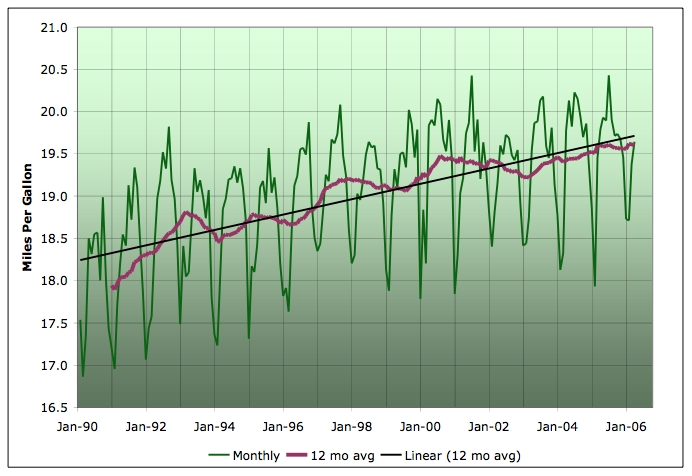
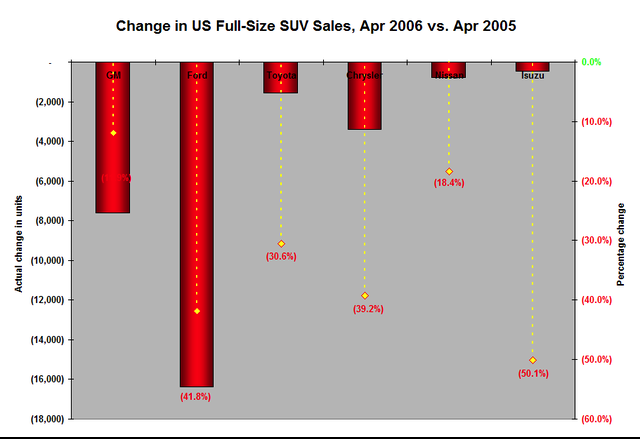
Can we see much other change?
Well, I started with my customary graph of monthly vehicle miles traveled (VMT - an estimate of total daily volume of vehicle travel by all vehicle types on US roads). That graph looks like this:
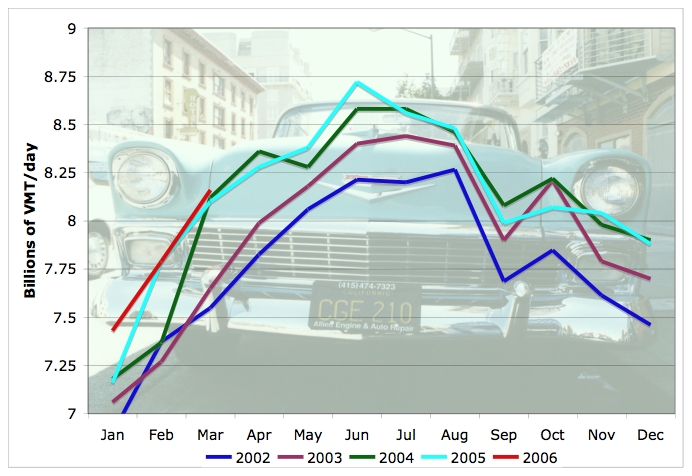
(Note that I added 2002, so the timescale now included the same period as my plateau graphs). The pattern of being roughly flat over the prior year continues.
Last time we talked about VMT stats, Halfin suggested that the monthly data might, because of its noisiness, conceal trends worth exploring. This seemed a fair point, and I decided to compile a monthly series going back as far as the Travel Volume Trends go (which is the beginning of 1990). That series looks like this:

This seems fairly as expected based on my past analysis of VMT statistics. There's a linear trend, there's seasonal fluctuations as people drive more in the summer and less in the winter, and then there's wiggles in the 12 month average due to the 2001 recession, and more recently due to the recent run up in prices associated with the oil supply plateau. You can see that VMT has gone roughly flat in the last year, versus its usual rise of around 160 million miles/day with each passing year.
But much more intriguing are the fuel economy stats. Last time, I started to construct a deployed fuel economy series by taking the finished gasoline supplied stats from the EIA, and dividing them into the VMT. The gasoline stats look like this:

However, I wanted to do a little better than just dividing all miles by all gasoline, since some miles are fueled by diesel. Unfortunately, I can't figure out a very precise way of doing this, since EIA doesn't seem to distinguish between diesel for transportation and heating oil in the product supplied statistics. Instead, I looked at vehicle types and made a correction based on that.
Here's the mix of vehicles contributing to US miles driven.
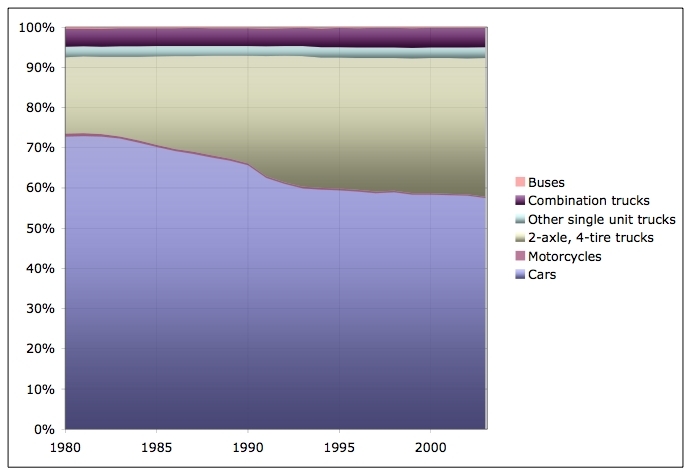
You can see that the big trend is that away from cars and towards light trucks. The proportion of everything else hasn't changed much. What I did was to assume that everything else (trucks with more than 4 tires, big trucks, and buses) runs on diesel, and light trucks, cars, and motorcycles run on gasoline. Obviously, this isn't altogether correct. Some cars and four tire pickups run on diesel, and some larger trucks run on gasoline. However, there isn't an obvious way to do better. Hopefully these distortions are at least fairly consistent from year to year. At any rate, here's the proportion of miles that are assumed due to diesel under this method:
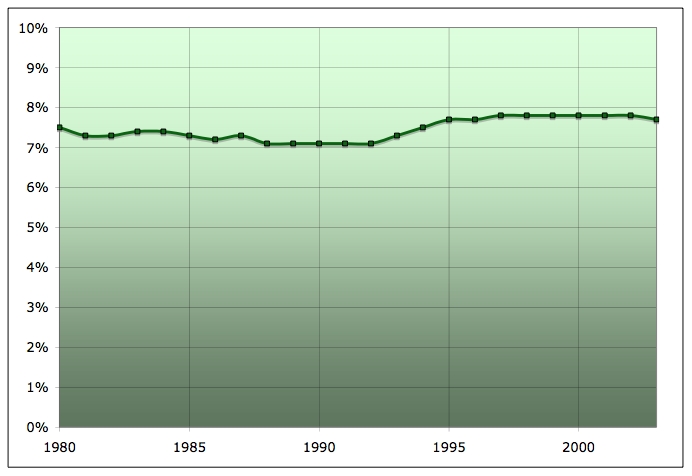
So in constructing my fuel economy series, I subtracted these miles out in an attempt to estimate miles per gallon only for the gasoline powered fleet. That results in this estimate (only from 1990 on, because that's all I have monthly VMT for):

Interesting! There are a bunch of slightly puzzling things about this graph. The seasonal signal we discussed at length last time, and the general feeling is that fuel economy is poorer in the winter because cars are less efficient in the cold. It's possible that a higher mix of highway driving during the summer is also a factor. However, the generally rising trend from 1990-2006 seems a little odd. Here's a graph of fuel economy of new vehicles from 1978-2005:

Firstly, it's worth noticing that the claimed efficiency of new vehicles has almost always been higher than what seems to actually happen on the road.
New vehicle mileage improved massively following the 1979-1980 oil shock (the Iranian revolution and Iraq-Iran war). Fuel economy of new vehicles peaked in the late 1980s, and then declined slightly to the mid 1990s, and then has been increasing very slighly since then. However, 1990 to the present is mostly flat, with signs of a more aggressive increase perhaps starting in 2005.
However, if we look at the age structure of the deployed vehicles, or rather the miles they travel:
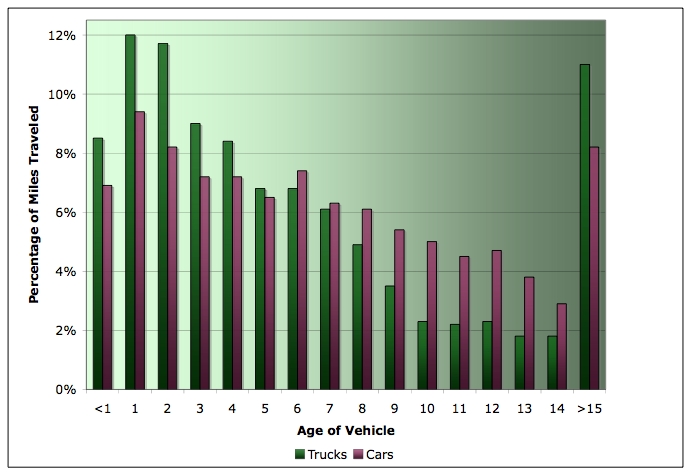
Clearly, even quite old vehicles contribute. So probably increases in deployed fuel economy in the 1990s were coming from the retirement of 1970s and early 1980s vehicles with poor mileage. That's mostly over now, and presumably further increases are coming from the renewed though gradual trend for efficiency in the last few years.
Another possibility is hinted at by this graph:
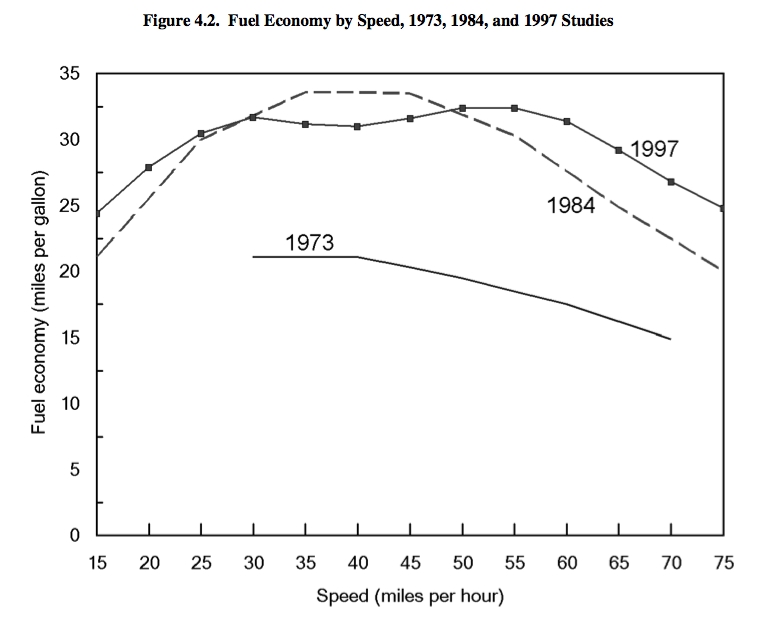
It appears that with time, manufacturors have been making cars that increasingly do their best mileage at higher speeds. This might be improving the deployed fuel economy, but not be captured by the EPA's static CAFE profiling methodology.
Finally, when I stared at the fuel economy graph, the wiggles in the moving average away from the linear trend looked familiar. Sure enough, when I pulled out a chart of GDP changes, there's a pretty good visual correlation to my eye. It appears that fuel economy improves when GDP is growing strongly, and regresses when GDP growth is weak:


I haven't explored this further yet, but my guess is that during good times, people buy newer (and on average more efficient) cars. During bad times, people hold onto old inefficient vehicles (which are presumably getting less efficient all the time).
Obviously, this effect could markedly counter the beneficial effects of increasing fuel economy on peak oil. New cars might be getting more efficient, but if there's an economic slowdown (and the Fed now seems to be getting trapped into more interest rate rises by the inflationary pressures that are due in large measure to energy prices), reduction in car sales will limit the benefits.
Your thoughts?




mpg = 18.2 + 0.1 X (years from 1990)
The doubling time to get 36.4 mpg will be 182 years ie by year 2172. Maybe not.
I suspect that for the next few years there will be no stable ratio involving fuel use. When Michelson-Morley found that light always had the same speed they weren't dealing with the cussedness of human behaviour.
My common sense leads me to think that this is wrong. Once warmed-up an internal combustion engine should provide more horse-power in cold weather. A more compressed mix that goes into the combustion chamber and the wider temperature difference between the engine and the environment should allow it to produce more work.
Those seasonal fluctuations on fuel efficiency are a bit strange, but can be explained by the different driving patterns during the summer. Although a car has a better fuel efficiency at `not-so-fast' speeds (80 - 90 Km/h), it will be far more efficient on a Highway at 120-140 Km/h, than on traffic at 60-70 Km/h.
Beyond looking at efficiency we must also look into inefficiency: it is during the stop-and-go that a car has the worst MPG or L/100Km figures. Since during the Summer we are mostly on highways and freeways we are avoiding the usual traffic jams and traffic lights, that bring the car's efficiency down.
(In California I haven't noticed a lot of seasonal variation.)
Formulations do change in the winter. The most significant change is that the butane in the gasoline pool increases from about 2% to about 10%. I suppose this could affect fuel efficiency.
RR
Don't mistake performance for efficiency. Cold air is more dense so more air can pack into the cylinder chamber. Fine. It's still colder than summer air and the energy to warm it has to come from the compression stroke. That means the temperature at ignition is lower. Since it is denser there can be more fuel injected and an overall higher power output. That does not imply the efficiency is greater because it takes more fuel to get that additional power. It's more complicated than it seems.
Wind drag is the biggest factor slowing wheeled motor vehicles above 30mph or so. Wind drag increases with the square of the speed, while tire drag is pretty much linear with speed, and the various forms of engine drag vary with engine speed. Air in winter is significantly denser than air in summer, so drag increases in winter.
On someone else's point, people may drive more on highways in the summer, but there are far fewer orange-barrel obstacle courses in the winter. I suspect that road construction has a mixed effect on summer motoring efficiency. On the one hand, there are more traffic backups due to construction. On the other hand, motorists are forced to travel at lower speeds in construction zones, which in some cases will mean they are getting better mileage!
IMO this is a very important concern, and it goes beyond vehicle mileage to energy efficiency generally. The world has been awash in liquidity lately, but that state of affairs appears to be unlikely to continue. It isn't just the Fed that one has to watch (see for instance The Nightmare Carry Trade Scenario). I would argue that credit tightening is both inevitable and imminent, and that it is likely to have a very significant effect on the availability of resources for funding efficiency improvements on all fronts.
US consumers are over-stretched and any further tightening could easily push them over the edge, particularly in relation to housing. Altering structural inefficiency is an expensive business. People who are underwater on their mortgage and struggling with credit card debt are unlikely to be buying more efficient vehicles, even if the fuel consumption of their current vehicle is crippling them. The same argument would apply to replacing inefficient appliances or installing improvement such as solar domestic hot water. Rather than increasing efficiency, people are likely to be forced to keep using their current vehicles and other energy-consuming items, but to use them less as energy prices rise relative to other costs.
This graph suggests that rapid changes in fuel efficiecny can occur during a time of economic stagflation as this is exactly what happened in the 70' & 80's. Granted the lifespan of a car is longer today so the impact will not be seen as quickly but if there are several models on the market today that get 40+ mpg, why couldn't there be a gradual shift over 10 to 15 years from our (U.S.) current efficiency of 22 mpg to 30 or 40 mpg? Actually I hope we abandon the car as the centerpiece of our transportation infrastructure and choose mass transit and local communities as a response to peak oil but I fear Americans will try to keep the suburban "lifestyle" as long as possible.
Indeed, the question becomes how quickly could a turnover occur. Certainly not as fast as it was in the 70's and 80's as cars are on the road longer but you've put forth the argument several times that if decline rates are modest say 2 to 3% society might be able to absorb that. Could we not improve fleet efficiency by 2 or 3% a year as gas guzzlers are slowly retired in favor of more efficient vehicles?
I would want to see the context of the remark by Peter Tertzakian.
For example, if a sizable percent of the fleet were converted to a non hybrid Diesel model, example of what is currently available in Europe below...
http://www.vwvortex.com/artman/publish/printer_319.shtml
Would that not have an effect on fuel consumption in a big way?
Several posters here in the debates about bio-fuels have also pointed out that bio Diesel has much better energy return on energy invested than ethanol, but is only held up by the fact that most Americans do not like Diesel cars AT ALL. But, if fuel prices continue to climb, a 70 mile per gallon small "suburb saver" begins to make sense. With a hybrid electric drive or some version of hydrualic hybrid, this could be theoretically raised to around 100 miles per gallon, and with plug hybrid as batteries improve, the sky becomes the limit.
Would a person be willing to accept this kind of solution if the other choice is to abandon a quarter million dollar or more investment in the suburbs, their friends and social network, schools lifestyle, etc., and flee to a cave or shed in the country?
oh yeah.
The suburbs ain't going anywhere soon.....
Roger Conner known to you as ThatsItImout
We'd need to make every new car a high efficiency model (be it hybrid or something else), and we'd have to enforce retirement of older guzzlers.
Is that going to happen?
Transportation is only 2/3 of US Oil Consumption. Private auto use is about 9 million of 21 nillion barrels/day.
Cutting 9 million in half would be a good first step. BUT IT WOULD NOT SOLVE THE PROBLEM
-4.5 out of 21 is (round #s) just a 21% reduction in US oil use. If, as seems likely to me, the US will be forced by economics to take a higher than average reduction in world wide oil use. this might be equal to a global -14% reduction in world oil production. Perhaps 5 years past peak ?
A graph of US oil use by demand type.
http://www.eia.doe.gov/pub/oil_gas/petroleum/analysis_publications/oil_market_basics/Dem_image_US_co ns_sector.htm
The "heartbeat" of apparent fuel mileage is inconsistent with VMT trends shown for all years. I suggest the rise and fall is dominated by the gsaoline delivered which reflects refinery operations and the effects of "changeover" and not the driving patterns.
Second, although vehicle efficiency is affected for a short period of time by air temperature, unless one has a stuck thermostat, the combination of fuel injection (for most vehicles), OBD II on all post-1996 vehicles, and the use of 3-way catalysts on all post-1996 gasoline powered vehicles pretty much negates the old "cold weather" effects on gasoline powered engines. It is possible if you only drive a couple of miles, that you never reach peak operating temperature, but that seems more and more rare.
Finally, somewhere the EIA does make the distinction between fuel type usage with the VMT and fuel economy. While I think you've captured the general trend towards larger vehicles offsetting slightly improved passenger car efficiency, I think the EIA has done their calculations and put them where you might not look for them. If memory serves, they are under the CO2 emissions estimates. I'll see if I can track them down.
The question involves: gasoline-hybrid vs. turbo-diesel.
Next month I plan to buy a new car, and high gas mileage will be the top consideration. Best gas mileage is currently the Honda Insight (a hybrid car that hasn't proved popular due to the fact that it's a two-seater). The EPA figures show it gets around 60 mpg.
It's chief competitor (for me) is the VW Golf turbo-diesel, which gets worse mileage, but still not bad at 40 mpg.
If gas mileage was the only consideration, I'd buy the Honda without a second thought. The thing is, I plan to reduce my driving to as little as possible. I'm moving to an area where I hope I can mostly leave the car in the garage and only use it on occasion. I have enough experience with gasoline to know that it doesn't store well. Leave gasoline in your tank for a month, and it starts guming-up, eventually requiring repair work on the carburetor or fuel-injection system to get it started again.
On the other hand, I have no experience with diesel. I suspect that it is much less likely to gum up, but I don't know that for a fact.
So those of you who have expertise in this field, the $64 million question is: which stores better, gasoline or diesel?
Thanks in advance.
- Robert
I assume I can forget about biodiesel in cold weather, so I'm just asking about the fossil-fuel stuff.
Newer diesels probably do better.
To deal with cold, they have glow plugs to preheat the engine, and bigger batteries. You need to look after the car battery well; replace it preemptively if it gets sluggish in winter. If you hole the car up for a few months at a time, battery life is the biggest risk. That said, in winter I use the car about once per month.
My new Touran does 40 miles/UK gallon, 10 miles/litre, on long haul work with bikes hanging in the back, full load of luggage etc; economy decreases the harder you drive it above 75 mph. the 6 speed gearbox keeps the rpm down, but you cannot do anything about drag.
What the golf-based minivan does have that is interesting is
-Catalysed diesel engine to meet latest EU standards. I actually pay less road tax on that than the 1.6L Golf my wife drives.
-this wierd pollution reducing preheater that burns a bit of raw diesel in a pan under the engine on very cold days. Its all automated, but the first time it happens and you see smoke coming out from near the right wheel, you are pretty scared. When the VW car repair people came round they explained it all and said that the dealers are meant to warn you, but clearly forget.
Finally, diesel does wax up at low temperatures; I think gas flows more freely.
And almost all automobiles - gasoline or diesel - have block heaters in Finland, and many new automobiles come with fuel-powered pre-heaters; a retrofitted fuel-powered heater for a passenger car costs something between 1000 and 2000 €.
If you are going to be storing gas in the tank for a "long time" i.e. > 2 mo. there is an additive you can buy to stabalize the fuel. "Stabil" is one name brand that comes to mind. You dump it into the tank when you fill up and it will extend the gas to 6 mo +
Sould be available where you buy motor oil and spark plugs...
I use this in the 5 gallon "emergency" jerry can I keep in the garage, and in my snow blower, which only uses a few gallons per season.
Diesel will store a long time as long as it is kept clean and "dry" i.e. in a situation where water condensation does not form in the tank. Injector systems do not like getting wet and I'm not sure if car engines have water filters in the fuel lines (most commercial stationary engines do)
Read more on it here:
http://www.chevron.com/products/prodserv/fuels/bulletin/longterm_gasoline/background-info.shtml
Also, I hear that electric cars get much, much better gas mileage than hybrids. (-:
No problems do far and my mechanic recommedns it.
Glow plugs glow longer in colder weather. An engine block heater is installed on mine (no need in New Orleans ~ :-)
I run Mobil 1 5w40 (their diesel rated synthetic oil),
With ultralow sulfur diesel coming on-line now, oil changes and engine life should improve a bit.
GreenEngineer, glad you mentioned that, that was the only thing missing from the discussion until you posted....we always called it fungus here in the south, but on my two Diesels, (one of which has sat up to a half year without being started the algae or fungus was the only issue, readily cured by an additive, and good filter maintainence...otherwise, Diesel stores great....I have often seen heavy equipment set outdoors through the winter season, and then start up fine in the spring and go to work...on the cold start issue, I have started both my 240D and 300SDL turbo in the single digits without use of th block heater.....it cranks hard with a groan but they started!
I am still dreaming of the day we get this car, which I mentioned in another post on this board...
http://www.vwvortex.com/artman/publish/printer_319.shtml
70 plus miles per gallon on a turbo Diesel!! Oh yeah, and think of it combined with the hybrid drive train! All I can say is if we would make the right choices, the OPEC gang better be running out, or we could stick their butt with a full desert still half full of them "devils tears". :-)
Roger Conner known to you as ThatsItImout
I have driven a 2005 Toyota Prius since Aug 2005, and just recently replaced it with a 2006 Jetta TDI so some observations on both.
I live in southern California but spent January through May in the Denver metro area.
The Prius does VERY well city or highway in the mild weather of southern California (averaged about 43-44 MPG mixed and 50+ in steady-state cross-country driving at 65 MPH). Even in exclusively in-town driving the mileage never went below 41.
Arriving in Denver in the cold weather of January (low 30's Farenheit), the mileage in mostly-intown driving plummeted to the low 30s. I was somewhat puzzled by this since I had thought the Carnot cycle should get MORE efficient with colder intake air. I am guessing that the chill factor of colder air blowing over the OUTSIDE of the engine block (causing thermal losses through the cylinder walls) was more that offsetting the theoretical advantage of colder air intake INSIDE the engine.
I then discovered that "Regular" unleaded in Colorado is only 85 octane compared to a minimum 87 in California and most other states. [ The Prius manual recommends a minimum 87. ] When I started using "Premium" 91 (Costco doesn't offer midgrade which in Colorado is 87) the mileage went up to the upper 30s. The mileage increase was far more than the 20 cent/gal added cost of premium.
[ The car runs perfectly on the lower grade 85 (no hard starting, rough idling or hesitation on acceleration), just lousy mileage. I attribute this to the ability of modern feedback-driven controls on fuel-injected engines to effortlessly accommodate varying fuel quality. ]
I then found one station in Ft Collins selling gasoline with NO ethanol in it. [Conventional MTBE blend???] The cold-weather mileage on the ethanol-free 85-octane "regular classic" shot up from the low thirties to the low forties.
My guess is that some combination of thermal losses, and the way the "exaust sniffing" feedback engine controls react to the combustion products of ethanol-laced and/or reduced-octane fuel contribute to the reduced milage.
By the end of my stay in late April-early May when the prevailing weather had warmed up to the 60's (Farenheit) and higher, I was observing average milage in the upper forties on the ethanol-laced Costco 91 "premium".
Conclusion: The high-efficiency Prius engine system is VERY sensitive to both outside air temperature and to fuel grade.
The Prius hybrid drive system is extremely efficient and works well in in-town driving but is terrible in mountain driving. When you start up a grade (such as I-70 west out of Denver heading up into the Front Range toward Evergreen), the combined gas and electric drive initially provides plenty of power. [ Hybrid Synergy Drive combines the 50KW (approx 60 HP) electric motor with the 70 HP gas engine. ]
However if the upgrade is more than about 7 or 8 miles long, the battery becomes exhausted. The 70 HP gas engine then has to handle 100% of the load. The continuously-variable transmission moves down to something like the equivalent of "second-and-a-half gear" while the small gas engine winds up to 5000 RPM+ and screams like a motorcycle.
Once over the summit, the gas engine shuts down as the car rolls downhill. The electric motor reverses roles and is driven by the wheels as a generator to recharge the battery. The charging load puts a drag on the wheels that neatly emulates compression braking of a traditional combustion engine on a downgrade.
Until the battery is fully recharged (typically 5-10 miles depending on grade). When the generator load is removed from the wheels at full charge, you suddenly have no drag at all, forcing you to ride the brakes for miles at a time. [ The Prius does have a "B" - Braking position on it's shifter but it just engages the regenerative braking mode of the motor/generator. It doesn't do anything once the battery is fully charged. ]
There are many design elements in the Prius besides the Synergy Drive hybrid power system that have been made to boost mileage. One of these is narrow relatively high-pressure tires. These reduce rolling friction and boost mileage on level ground. They also reduce rolling friction (i.e. traction) in the mountains. In sloppy slushy weather, the downgrade from the Eisenhower summit or the Vail Pass on I-70 is terrifying with minimal tire traction and without the classic compression braking in play.
The Prius replaced a '97 VW Passat TDI turbo-diesel wagon with a quarter-million miles on it. That car averaged 41-42 MPG with a 5-speed manual transmission. (And handled itself very well in the mountains. The amazing low-end torque of the diesel would allow it to effortlessly climb the I-70 upgrade west out of Denver (or the I-5 "Grapevine" summit north of Los Angeles) on cruise control at 70MPH in fifth gear.
A month ago, I replaced the Prius with a 2006 Jetta TDI with the 6-speed "Tiptronic" transmission. This transmission is not a conventional automatic with the slippage of a fluid clutch - rather it is essentially a robotically-shifted manual transmission with TWO dry clutches.
You can operate it in either of two full-automatic modes: A normal "Drive" mode where the computer shifts each time the engine hits about 2000 RPM for best fuel economy, or in a "Sport" mode where the shifts are delayed until the engine hits 3500 RPM, for best acceleration. Or you can put it into a manual mode where you can force the gear changes yourself.
For fast takeoffs on freeway on-ramps, the Sport mode is absolutely amazing. You've never seen a diesel move like this before. I swear if this wasn't a front-drive vehicle, it would do wheelies. You can switch between the three modes at any time, even while the car is moving at highway speeds. [ The shifter FEELS like a mechanical device with heavy detents, but it's actually all fly-by-wire -- a shaft encoder passing bits into a computer. Elegant user interface IMO. ]
On the trip back to Los Angeles, I left Denver in very mild clear spring weather. The TDI did the entire upgrade before the tunnel at 70 MPH in 5th or 6th gear on automatic. [ In automatic modes, the dashboard display constantly shows which gear the computer has currently selected. ]
I emerged from the west end of the Eisenhower tunnel (which passes under the continental divide to the west slope of the Front Range of the Rockies) into a rather nasty rain & snow storm right around freezing. At 50 MPH, I flipped the Tiptronic from Drive to Manual, forced it down from 6th to 3rd, decelerated to about 40-45 MPH without braking, and negotiated the slippery downslopes into Vail (4000 foot descent) absolutely effortlessly. What a difference compared to this trip in the Prius!
On the 1100 mile trip from Denver to L.A., the Jetta TDI averaged 49 MPG. And that was with a car with only about 1000 miles on it when I started; i.e. engine and drive train not yet fully broken in or loosened up. In town the mileage isn't as good as the Prius (in warm weather at least). The TDI has been averaging mid-to-upper thirties in town and is now consistently hitting 50+ in steady-state cross-country driving. In my past cold-weather experience with the Passat TDI, the mileage was affected very little by cold weather. Haven't had a chance to try extended driving in cold weather with the new Jetta.
BTW, I never had cold weather start problems with the Passat TDI even in the bitter cold of Idaho in January (-10 degs Farenheit). In cold weather, a thermostatic switch starts heating the new-generation fast-heat glow plugs as soon as you unlock the driver's door and open it, instead of waiting for you to get seated and turn on the ignition. There is no glow-plug pre-heat cycle at all in temps above about freezing. You just get in and start it like a gas engine.
The one critical issue for cold-weather diesel starting is that you absolutely must have a healthy battery. A diesel engine has to be spun aggressively by the starter (i.e. 300-600 RPM)to fire, not just be barely turned over like a gas engine. Further, in really cold weather, you need to have winterized diesel fuel (which stays more fluid and volatile at low temps at the expense of a 20-30% mileage hit) in the tank. If you unexpectedly find youself in a really cold place with normal summer diesel #2 in the tank, you can pump in a small amount of gasoline to make the blend about 5-10% gas.
Excellent write-up overall, but for what it's worth my Prius manual claims "B" is engine braking. I thought that was pretty wild and tried it coming down the grapevine (I-5 north of LA) to see if I sounded like a semi. It does something, but not much, so I didn't stay in "B" too long.
(on my in-city mileage I still find that trip distance is the big factor. 35 mpg if the day is made up of 2-3 mile hops, 45 mpg with 3-5 mile hops ... I start climbing to 50 mpg on longer outings. this pattern has been very consistent as I restrucy computer in the morning and just see how the day goes.)
In Northern New Mexico the gasoline octane rating is 83 (average altitude is 7000 feet amsl) allowing straight-run gasoline with very little reformate to be used for regular unleaded.
I assume that the closed-loop feedback-based engine controls with knock sensors can accomodate themselves to the fuel characteristics in real time. Presumably, they react to the higher-octane less knock-prone fuel by triggering ignition earlier allowing for a more complete burn.
For those that haven't seen it, one of the the neat features in the Prius is the MFD (MultiFunction Display color LCD panel). One of it's display modes is a scrolling histogram (bar chart) of mileage averaged over 5 minute intervals for the previous half-hour. [This is in addition to the instantaneous mileage display and and a long-term average since the last fillup.] It's really eye-opening to see how bad the mileage is when the engine starts out cold, and then watch the milage move steadily upward in the following 5-minute intervals for the first 15 minutes as the engine warms up. It is real psychology to get you to combine trips to try to get those bars as tall as possible as soon as possible, and then keep them up there!
You can also get nearly immediate feedback on the effects of different grades of fuel when you fill up after you've been driving awhile and have the engine fully warmed up.
The effects of "rotgut" ethanol-laced gasoline compared to straight "gas classic" are immediately obvious (within 10 mins or so) with this display! Again, since the actual energy content of E10 gas is only 3-5% less than "gas classic", I assume there is something about it's knock characteristics or combustion products that the engine control sensors "don't like" or mis-interpret.
It is nice to see that the 12 month moving average for retail gasoline sales has leveled off - in a pretty striking way.
That is very positive news.
* - of Stuart's many excellent charts, this one:
http://www.theoildrum.com/uploads/12/monthly_gasoline.jpg
I drove north on I-77 through Ohio on saturday morning to see a family member's graduation. I was struck by the number of SUV's and minivans travelling south with beach gear or other stuff on their roof rack. This is the time of year when hundreds of thousands of Ohioans head south to the Outer Banks of NC, Myrtle Beach of SC, etc. At one point I decided to count vehicles. 18 out of 200 consecutive vehicles had stuff on their roof rack indicating a vacation. There had to be at least a few vacationers without a roof rack or who can store everything for vacation without using a roof rack. It must have been at leat 10% of the south-bound traffic heading out for vacation at that time! I don't think "demand destruction" has hit the middle and upper-middle class yet. The demand destruction we've seen is probably coming mostly from the very poorest of our society. Many of my public assistance patients will make an effort to schedule all their doctor visits and medical tests on the same day so they only have to drive into town once a month. Around here, the poorest people live in trailers out in the middle of nowhere. They are being hit very hard by high gas prices bc/ of their location.
For what it's worth, I just tried a search for the average distance covered in a driving vacation. I recall that it was reported as 400 miles last year, but anything in the 400-1000 mile range is small in comparison to a family's yearly driving. I suspect (one more of those things not shown by the numbers) that the summertime blip is made up of all those weekend things we do all summer, things that are not really "vacations." It's June and it's time to get out of the house.
A friend of mine is making the drive every Saturday and Sunday to a semi-local Renaissance Faire ...
My boss' mother-in-law babysits his kids. She drives in summer, but in winter, she takes the train. He hates it, because he has to pick her up and drop her off at the train station, but she won't drive the 1-1/2 drive in winter.
Last year, when driving from NC to Nashville, 9 out of 10 license plates (of the vehicles that passed me) were from Ohio. Simarly, when I used to spend much more time in Myrtle Beach (the number of vehicles from Ohio and PA are impressive.
Makes me wonder if "anybody's home" in those states during the summer.
Seriously though, you're right. Everyone in Ohio who can even marginally afford it goes to the beach at least once every summer.
My wife is in lots of different community groups bc/ she's a stay-at-home mother and a very social person by nature. During the school year she has not less than 8 or 9 meetings a week. In the summer, they're all cancelled bc/ not enough people are around to sustain the activity!
It might be interesting to tease out the details of this and study his assumptions.